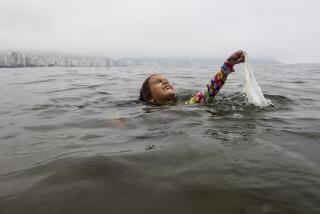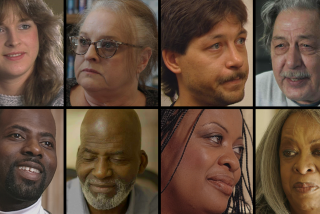Review: What a family learned by ditching their smartphone-addicted lives to roam the world
An American family has moved to Holland, where their older daughter’s conduct at school has landed them in a meeting.
“You can see a revolting attitude in her,” the Dutch educator says of the 11-year-old — who, back at home, was merely a quirky, opinionated, smart, above-average kid. “First of all,” the girl says in response, “you tell me that I talk too much, and then you talk to me for like eight minutes straight.”
The parents are aghast, a bit amazed. What have they done?
A year earlier, Dan Kois was sitting in a hot tub in Iceland, on assignment for The New York Times Magazine, where he is a contributor, and where he has written several memorable and charming features. (The one about playing cards is great, and appears in this book.) He’s also an editor at Slate, founding host of the “Mom and Dad Are Fighting” podcast, and writes an engaging Twitter account.
The Iceland trip sticks with him: How could families and mayors and lawyers and bricklayers all soak together, every night, when his own family was always so busy back at home, lusting after screens, everyone somehow bored and also miserable. It comes to a head when his younger daughter, Harper, is lying awake, close to midnight, lights on and teeth gritted. “I can’t turn it all off!” she cries.
“[W]e were fundamentally living the wrong life … we were doing being a family wrong,” Kois decides.
So he and his wife, First Amendment lawyer Alia Smith, suddenly decide, without really consulting the children, to do what many of us have only dreamed of. Seeking togetherness, adventure, adversity — but not the kind where you’re late for soccer practice in suburban Arlington, Va. — and wanting to discover “an existence that made more sense,” they leave it all behind. They resolve to spend four months in each of the following: New Zealand, a midsized city in Holland, a beach town in Costa Rica and a town of 20,000 in Kansas.
Some bumps in the resulting book, “How to Be a Family,” surface early as both a function of some less-than-stellar writing and a set of quotes and bits of history and news that aim to situate us. A bleak example: “[A]lthough the popular American view of New Zealand is a country of jolly white people — some short like hobbits, some stout like dwarves, some tall like elves — in fact, New Zealand is rapidly becoming one of the most diverse countries on earth.”
Thankfully, Kois quickly recovers, returning to the kind of scene-based detail that animated his work from the Iceland trip that inspired the whole saga.
The way Kois describes the neighborhood sharing a communal trampoline is particularly rich. But soon, after backyard parties and excursions to edenic wild places in New Zealand and even some acquisition of the Maori language, a reader may be just as devastated as the family is when they decamp for Delft, Holland.
Matching the power of his insight about New Zealand’s accident insurance fund, which allows his kids to play on a random trampoline without worrying about liability, Kois recounts the startling way Holland gave up being car-centric following a 1970s initiative called “Stop the Child Murder.” Fifty years later, the country is fundamentally oriented around bicycling; the family gets by without a car for the four months they live beside the canals.
The book doesn’t just amusingly collect magazine-length anecdotes; it’s in Holland that the most important goals of the book begin to coalesce. This book shows how one family works, as a way of helping us all ask ourselves: How might (and ought) our own families best function?
The family ends up in Kansas, which feels anticlimactic, but magically, these pages are the book’s best, featuring reporting and personal reflection and a section on faith that might be the start of a next big project. One of the greatest revelations? Kois discusses the power of a local public library, staffed by 20-something English majors, to give Kansas kids some privacy and a place to learn about a world far beyond the small town’s borders.
The year over, this book cruising to an end, now what? In New Zealand, everyone was happy to be “middling,” to be a “dog,” whereas in Holland the goal is to be “normal.” Costa Rica lets people check out from whatever seems to constitute real life for most of us. Maybe it’s Kansas, where Kois gets back in touch with the avocation he’s long ago abandoned (theater!), that has the room and pace to let a guy figure out who he really wants to be?
This is, and the author owns up to it, a deeply upper-middle-class, white and East Coast book. Readers of a Los Angeles-based newspaper, for example, might have mixed feelings to learn that one apparent solution to the family’s problems might be … moving to California.
Without giving away what actually happens, consider this: It’s hard to imagine it not being a fun project to discuss this book with people you care about, who also care about you. Because, spoiler: What matters most to the Kois/Smith clan, even more than ambition and being part of the national conversation? Friends and family.
The best scene in the book finds the author riding along a Costa Rican beach at sundown with daughter Harper, their tires making a quiet shhhhhps sound on the sand. “This is so beautiful,” he says. “Will you remember it with me?” “Yes,” she says. “For my whole life.”
Deuel is the author of “Friday Was the Bomb; Five Years in the Middle East.”
“How to Be a Family: The Year I Dragged My Kids Around the World to Find a New Way to Be Together”
Dan Kois
Little, Brown and Company: 336 pages, $25.98
More to Read
Sign up for our Book Club newsletter
Get the latest news, events and more from the Los Angeles Times Book Club, and help us get L.A. reading and talking.
You may occasionally receive promotional content from the Los Angeles Times.






